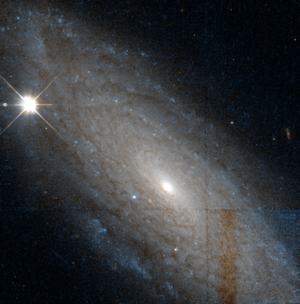NGC 1325
| Galaxy NGC 1325 |
|
|---|---|

|
|
| Photo from the Hubble Space Telescope | |
| AladinLite | |
| Constellation | Eridanus |
|
Position equinox : J2000.0 , epoch : J2000.0 |
|
| Right ascension | 03 h 24 m 25.6 s |
| declination | -21 ° 32 ′ 39 ″ |
| Appearance | |
| Morphological type | SBbc |
| Brightness (visual) | 11.4 mag |
| Brightness (B-band) | 12.2 mag |
| Angular expansion | 4.8 ′ × 1.6 ′ |
| Position angle | 56 ° |
| Surface brightness | 13.5 mag / arcmin² |
| Physical data | |
| Affiliation | Eridanus cluster |
| Redshift | 0.005307 +/- 0.000017 |
| Radial velocity | 1591 +/- 5 km / s |
|
Stroke distance v rad / H 0 |
(68 ± 5) x 10 6 ly (20.7 ± 1.4) Mpc |
| history | |
| discovery | Wilhelm Herschel |
| Discovery date | December 19, 1798 |
| Catalog names | |
| NGC 1325 • PGC 12737 • ESO 548-007 • MCG -04-09-004 • IRAS 03221-2143 • 2MASX J03242556-2132385 • SGC 032212-2143.1 • GC 705 • H IV 77 • h 2534 • UGCA 70 • LDCE 251 NED008 | |
NGC 1325 is a barred spiral galaxy of the Hubble type SBbc in the constellation Eridanus in the southern sky . It is estimated to be 68 million light years from the Milky Way , about 95,000 light years in diameter, and a member of the Eridanus Galaxy Cluster . The galaxies NGC 1315 , NGC 1319 , NGC 1332 , IC 324 are located in the same area of the sky .
The supernova SN 1975S was observed here.
The object was discovered by the astronomer William Herschel on December 19, 1798 with his 47.5 cm reflecting telescope .
Individual evidence
- ↑ a b c d NASA / IPAC EXTRAGALACTIC DATABASE
- ↑ a b c d e f SEDS : NGC 1325
- ↑ Seligman ( Memento of the original from September 10, 2015 in the Internet Archive ) Info: The archive link was inserted automatically and has not yet been checked. Please check the original and archive link according to the instructions and then remove this notice.
